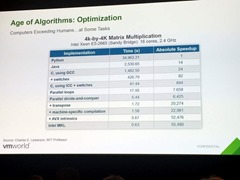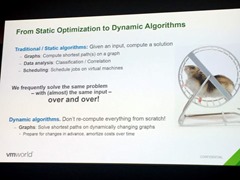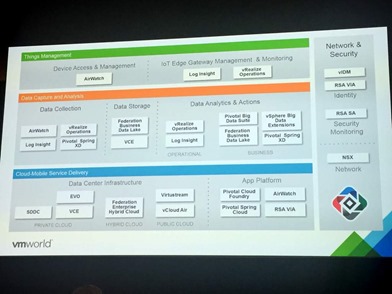VMworld EU 2015 Buzz: Hot Topics in VMware Research – CTO6660
Adding some more colour to the highlights from my VMworld Europe 2015 coverage:
- VMworld Europe 2015: The Day –1 Buzz
- VMworld Europe 2015: The Day 0 Buzz
- VMworld Europe 2015: The Day 1 Buzz
- VMworld Europe 2015: The Day 2 Buzz
- VMworld Europe 2015: The Day 3 Buzz
Presented by David Tennenhouse – Chief Research Officer (cool title), VMware
VMware has always been very academic research focused likely due to it being founding and having its head office in Palo Alto, home of Stanford University. Founders Mendel Rosenbaum and Diane Green were academics. VMware still maintains a serious academic programme partnering with researchers in systems and networks and invests significantly to maintain its innovation pipeline. David started the session talking about the challenges of being an industry leader where being a fast-follower is no longer an option. David went on to talk about some recent research trends and how he sees them shaping the industry.
More and more things are being virtualised including what he called heterogeneous computing such as GPUs and FPGAs.
There are new ways to build scalable and consistent distributed systems (he says this is having your cake and eating it)
David talked about the previous predictability for Moore’s law which allowed so many companies to plan their future on ever increasing compute resources. The increase of transistors is running out of room as the silicon space of the atoms is just getting too small. The only way to surpass this is to change how transistors are made. We will need to get improvements in other ways, in coordination across the industry. He said not to worry, it’s OK, there will be innovation beyond this with new materials.
Over the past 40 years we moved from a heterogeneous tech base with different architectures and ways of wiring things together to a homogenous tech base standardising on x86. This allowed the industry to massively decrease costs.
CPU frequencies are not going up, number of cores have increased but this is likely to come to an end due to power issues. There are also now specialised features on chips particularly in mobile, running, GPUs, crypto, cameras and other image DSP on a single chip. Adding FPGAs is what some people are working on. This means we are moving away from the the existing homogenous tech base back to a heterogeneous tech base.
How does it affect virtualisation which has taken huge advantage of homogeneaity which allows vCPU, vNIC, vDisk etc. across different hardware.
Virtualisation: Hide Diversity
Specialisation: Explore Diversity
David then went on to talk about doing new things to improve computing if Moore’s law is slowing. Algorithms to the rescue! Hardware people gave more and more cycles, now it will be more efficient algorithms. We had plenty of excess capacity with hardware with people trying to work out what to do with it, capacity will become scarcer so we need to get more efficient.
Academic research is sometimes ahead of adoption and like water building up behind a dam, gathering a whole lot of knowledge. Algorithm research is there currently and being able to do things better in software is hugely important. Previously we had chips for hardware compression, now it can be done better in software.
An example he gave of performance increases is a 4k by 4k matrix multiplication. From doing this in Python to new algorithms allowed 55,480 times absolute speed increase which is a much better gain than the previous doubling for Moore’s Law.
David said code optimisation will be far better done by algorithms, it will be able to iterate through so many options that code will be able to get so much more efficient.
Algorithms will also move from traditional/static algorithms to dynamic algorithms.
There are also issues with scale. With Big Data, you can’t read it all efficiently. With Big Distributed Systems, you can’t know exactly what’s going on at every moment.
Traditional algorithms based on perfect knowledge and perfect optimisation are doomed to fail, we have to settle for approximation, using statistical tools.
David then talked about scalable distributed logs for sharding big data.
On to the Internet of Things. David mentioned that the difference now is sensors are connected and this is was makes IoT, the networked connectivity rather than just having devices.
You will have lots of cheap devices talking to a local gateway, its impossible to secure all the devices as they may cost fractions of a cent and will have code vulnerabilities discovered so security will need to be at the gateway assuming insecure devices.
For IoT, there are lots of products across the EMC (Dell?) Federation.
From VMware he sees AirWatch being used for device management and vRealize Operations for gateway management.
David then went through some other thoughts he’s been having on how we moved from batch computing to interactive computing. Now he says we are already in proactive computing where computers will know our needs and be able to service them.





Recent Comments